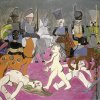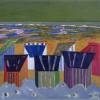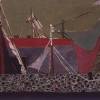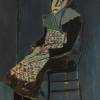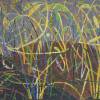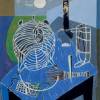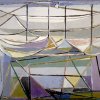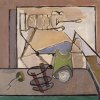Once the war ended with its deprivation of liberty and the academic aesthetics promoted by the occupier, the time has come for Van Lint to continue exploring a new visual language, which as in the example of elders as Ensor and Brusselmans, could bring definitive emancipation from the realistic view, a language in which a particular object of reality becomes an excuse to a more abstract recomposition - which will be called - "derealizing", by his first biographer, a language capable of expressing a new consciousness of life, both more anxious and subjective. In May 1945, Van Lint finds encouragement in this new artistic quest when he discovered the exhibition The Young French Painters (La Jeune Peinture Française) at the Palace of Fine Arts in Brussels. A month earlier, he had the second individual exhibition. Innovative events are accumulating in the immediate aftermath of the Liberation; on July 3, the association The Young Belgian Painters (La Jeune Peinture Belge) is launched at the initiative of Robert Delevoy and presided by René Lust, a lawyer. This association brings together twelve Belgian artists, the stars being undoubtedly Van Lint, Bertrand, Mendelson, and Cox. Some other thirty artists will join them afterwards. Louis Van Lint is chosen to represent his colleagues on the Board of Directors. The patrons who support The Young Belgian Painters acquired several works signed by the artist, shown at numerous exhibitions under his aegis: in Ostend, Paris (Galerie de France), the Hague, Amsterdam, and soon in Buenos Aires, Stockholm, Cairo, Zurich, Bordeaux, Brussels, finally in Oxford, Venice, Mons, Antwerp, Rome.

At each of these exhibitions, Van Lint distinguishes from his colleagues by the audacity of its pure and contrasting colors: “A magician of the palette with a vividness that individuates him", notes the Parisian art critic Gaston Diehl talking about The cabins (Les cabines ou les tentes), a canvas soon acquired by the Museum of Ghent. The artist focuses then on a new way to transpose reality (a cabbage, a basket, figurines and dolls, boats, a lamp, a musical instrument, a lattice, a face, an attitude), making use of both candid and contrasting chromatic harmonies, and a simplified design that cultivates the arabesque of the line and monumentalizes the color schemes. In this regard, a canvas as Still Life. Glass lamp (Nature morte. Verre à lampe), first acquisition of the Royal Museums of Fine Arts in Brussels) is one of the milestones of this evolution, as it foreshadows the artist’s imminent entry into abstraction.
